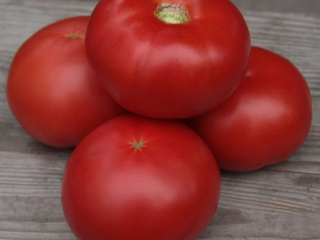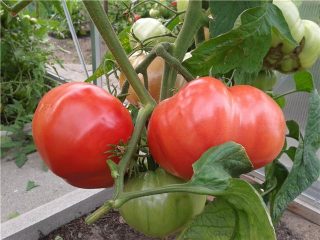Content
Raspberry miracle tomatoes are valued for their excellent taste, large fruits and high yield. This includes several varieties that have similar characteristics. All representatives of the varieties are resistant to diseases and difficult growing conditions.
Characteristics of the series
Description of Raspberry Miracle tomatoes:
- Raspberry wine. Mid-season hybrid for planting in a greenhouse. The bush is tall and requires pinching. The fruits have a rich taste and weigh about 350 g.
- Crimson sunset. Mid-early tomato for growing under cover. The plant reaches a height of 2 m. The fruits are large and have a round shape.
- Raspberry paradise. An early ripening variety that produces high yields. The weight of the fruit reaches 600 g. The pulp is juicy and sugary.
- Bright Robin. Tomatoes with an unusual watermelon flavor. The weight of individual fruits reaches 700 g.
- Raspberries. A variety with fleshy fruits weighing 400 g. Brings a high yield.
Description and characteristics of tomato varieties Raspberry Miracle:
- large ribbed fruits weighing from 200 to 600 g;
- smooth, raspberry-colored skin;
- juicy fleshy pulp;
- sweet taste;
- small number of chambers and seeds;
- increased dry matter content.
Grown fruits are suitable for preparing salads, sauces, soups, side dishes, and snacks. They are used for processing into tomato juice and canning.
Obtaining seedlings
Raspberry miracle tomatoes are suitable for growing in greenhouse conditions. Their seeds are first germinated at home. When the air and soil warm up and the seedlings become strong enough, they are transferred to a permanent place.
Planting seeds
Tomato seeds are planted in February or March, depending on the growing region. Prepare the soil in advance, which includes soil and humus. An alternative option is to use peat cups or purchased soil.
The soil from the garden plot is heated in the microwave to disinfect it. You can start planting 14 days after such treatment.
If the planting material is covered with a bright shell, then no additional processing is required. This shell includes a complex of nutrients that promote the germination of tomatoes.
The prepared soil is filled into containers, the height of which should be 12-15 cm. Seeds are placed on top with an interval of 2.5 cm. They are covered with a layer of peat or soil 1.5 cm thick.
Tomatoes germinate fastest at ambient temperatures above 25 degrees. Another condition is to place the boxes in a dark place. The top of the container should be covered with glass or plastic wrap.
Seedling care
For the development of Raspberry Miracle seedlings, certain conditions are provided:
- air temperature during the day is 20-25°C, at night – not lower than 10°C;
- regular ventilation;
- adding moisture;
- lighting for half a day;
- no drafts.
Tomato seedlings are watered with warm water. It is best to use settled or melt water. As the soil dries, water it with a spray bottle, being careful not to touch the plants.
If the tomatoes were planted in boxes, then when 2-3 leaves develop, they are picked into separate cups. The procedure can be avoided if the plants are already in separate containers.
2 weeks before transferring tomatoes to a greenhouse or garden bed, they begin to harden. Containers with seedlings are moved to the balcony or loggia. They are provided with access to fresh air for 2 hours. Gradually this period of time is increased.
Planting tomatoes
Tomato varieties are replanted 2 months after seed germination. Such seedlings have a height of about 30 cm and 5-6 fully formed leaves.
The place for planting tomatoes is chosen in the fall. Preference is given to areas where cucumbers, root crops, melons and legumes grew throughout the year. It is not recommended to plant in beds where any varieties of tomatoes, peppers, or eggplants grew.
In a greenhouse, the top layer of soil in which fungal spores and pests accumulate must be replaced. The soil is dug up and fertilized with rotted manure or compost.
It is recommended to place tomatoes in a checkerboard pattern. This simplifies planting care and harvesting, and the plants receive more sunlight.
Holes are prepared in the beds to suit the size of the tomato root system.Plants are transferred with a ball of earth. Then the roots of the tomatoes are covered with soil, which is compacted and watered abundantly.
Variety care
Raspberry miracle tomatoes produce a high yield with proper care. Plants need watering and fertilizing. The soil under the plants is loosened and mulched with straw or peat. Plants are regularly pruned to improve their fruiting.
Watering tomatoes
Regular watering of tomatoes is carried out a week after planting. During this time, the plants will have time to grow stronger and adapt to new conditions.
The watering scheme for tomatoes is as follows:
- until the ovaries form, the plants are watered weekly, and 4 liters of water are used per bush;
- During fruiting, moisture is applied 2 times a week in the amount of 3 liters per plant.
For tomatoes, less frequent but abundant watering is preferable. When there is a lack of moisture, the top leaves of tomatoes begin to curl. The intensity of watering is reduced during fruiting of tomatoes to avoid cracking of the fruit.
Tomatoes in closed ground or open areas are watered with warm water. The barrels are first filled with it and left to bask in the sun. Moisture is applied under the roots of tomatoes in the morning or evening.
Plant nutrition
According to reviews from gardeners, the Raspberry Miracle tomato stands out for its abundant fruiting. Fruit formation is ensured by regular feeding. Fertilizers are applied 3-4 times during the season.
The first feeding is carried out 3 weeks after transferring the seedlings to a permanent place. Plants are treated with complex fertilizer Nitrofoska. For a large bucket of water, 1 tbsp is enough. l. drug. The solution is applied under the bush when watering tomatoes.
There is a gap of 2-3 weeks between treatments. An alternative to mineral fertilizers is wood ash, which contains a complex of useful substances.
Bush formation
According to their characteristics and description, the Raspberry Miracle tomato variety is tall. Their formation allows the tomatoes to direct their forces to fruiting.
Every week, shoots growing from the leaf axils are pinched from the bushes. The procedure is carried out weekly. As a result, tomatoes are formed into one or two stems.
Protection from diseases
Raspberry miracle tomatoes are resistant to diseases. With rationing watering and proper formation of the bush, the likelihood of developing diseases is reduced. For prevention, plants are treated with fungicides.
Tomatoes attract aphids, whiteflies, mole crickets and other pests. Insecticides or folk remedies in the form of tobacco dust, wood ash, infusion of onion peels or garlic are used against insects.
Reviews from gardeners
Conclusion
Raspberry miracle tomatoes have good taste and impressive size. Caring for the variety includes the application of moisture and fertilizers. To increase the yield, tomatoes are planted. The fruits are used fresh or for further processing.















